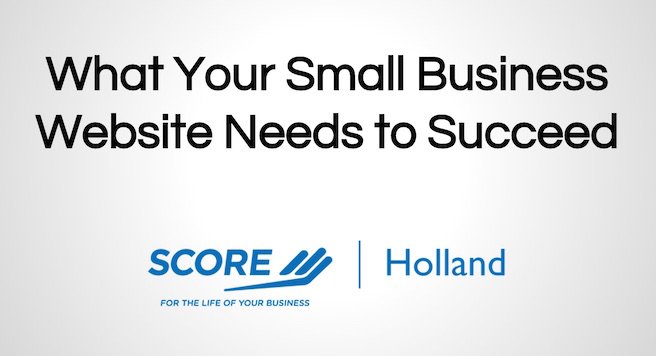
You know your small business needs a website, but simply having a website isn't enough. Do you know what it needs to succeed? Let's look at the content and design your website needs to meet your business goals.
I gave this presentation, What Your Small Business Website Needs to Succeed, at the Small Business Symposium hosted by SCORE Holland on March 2, 2015. Below are the slides and detailed notes.

Why do you have a website? It's not because everyone else has one, or because someone told you that you needed one. You have a website because it's a business tool, useful for marketing and/or sales. Keep this in mind as you face decisions about your website: everything about the site should support your business goals. To do this effectively, you'll need to define your business goals.
Which of the following are you trying to do with your website?
Even if you're selling, not everyone will buy from you on their first visit. Think of your website as part of the relationship-building process. The relationship may flow through the website, social media, phone calls, emails, and in-person visits. Use your website to guide this process.
A website's content is its text, images, video, etc. People come to your website for its content, not for its design. Focus on the content, then use the design to support the content. What content does your site need?
Whether your business has a physical location or not, you need to make it easy to find contact info. This could be a phone number, address, map, contact form, or links to social media. To make it easy to find, place contact info (or a link to your Contact page) prominently in the header (top of the site) or navigation menu. Make sure it's especially easy to find on mobile devices.
Since your business exists to provide products or services, you need to give persuasive descriptions of these. Don't just list them in a boring way; show why you're the best provider by showing what differentiates you from competitors. This often involves credibility enhancers:
You should have at least one call to action (CTA) on each page. A call to action is an instruction to site visitors, prompting them to take a step. It could be "contact us" or "call now," but more goal-focused CTAs work better, such as "start saving money," or "get more leads."
A good About page can be invaluable. You can try to describe your products and services as different than your competitors, but visitors may not grasp the differences, or they may be skeptical. Your About page can be persuasive by showing your expertise, experience, and personality. This is one place you can set yourself apart from your competitors. Don't miss the opportunity with bland paragraphs about your history, mission, and vision. Bring this page to life with text, images, and possibly video showing why you're right for the visitor. The page is called "about," but it should be more about how you can help them than cold facts about you as a company.
Your site needs to be regularly updated with fresh content. If visitors and search engines see your site as stale, they'll be less likely to see your business as active and successful. Here are a few ideas for adding fresh content to your site:
You don't want visitors to forget about you after they leave your site. You want their permission to market to them. Invite them to follow or interact with you. You don't need to offer a multitude of options; stick to those which your audience uses and which you can use most effectively. These may include inviting visitors to
Now that we've dealt with your site's content, let's look at its design. Your website is a big part of your brand identity, and people will judge your business based on your website's design. If the design is old or ugly, they'll likely see your business as behind the times or lacking style.
Is your site as professional as you are? Impressions matter, and prospects may be judging you by your site's design. There are several aspects that go into making a site seem professional.
Images (photos and graphics) say a lot about your business. A professionally designed logo lends much more legitimacy than one an amateur created. Professional photos of the people in your business are far more authentic than stock photos. Get photos of your people in action: creating your products, meeting with customers, working in your facilities, etc.
Use a clean, simple layout with plenty of whitespace that puts your content in the spotlight. Don't make it so busy and cluttered that it detracts from the content.
Use typography (fonts and text styling) that's appropriate to your business. Consider your industry (finance, education, technology, etc.) and business personality (traditional, established, progressive, edgy, new, etc.). Using Comic Sans on a high-end consulting website isn't going to help visitors trust you.
Make sure your site is mobile-friendly. This applies to the areas we've discussed: content, images, layout, typography. You want visitors to have a good user experience with your website, so they can do what they came for. Consider these stats:
Responsive design, meaning that your site scales to fit browser size, is the solution preferred by the web design industry and Google.
If you haven't yet created your website, carefully consider these aspects of content and design. If you already have a site, review it with each of these items in mind, and improve it as necessary.
Need help identifying what your small business website needs to succeed? Let's talk about how we can fix your website to get the business results you deserve. Contact us!
Brilliant post Chad! I'm with you on mobile marketing particularly with Google's new algorithm change set to drop soon. I love that you've mentioned setting goals and asking the customer just why they even have their website and what they want to achieve from it!
Thanks for the compliment and for sharing your thoughts, Maria.